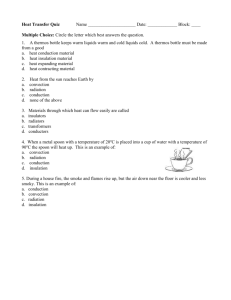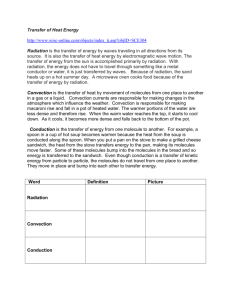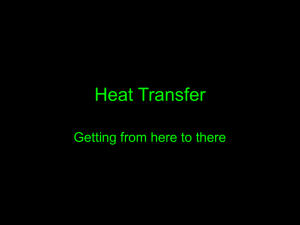Heat transfer PPT
advertisement
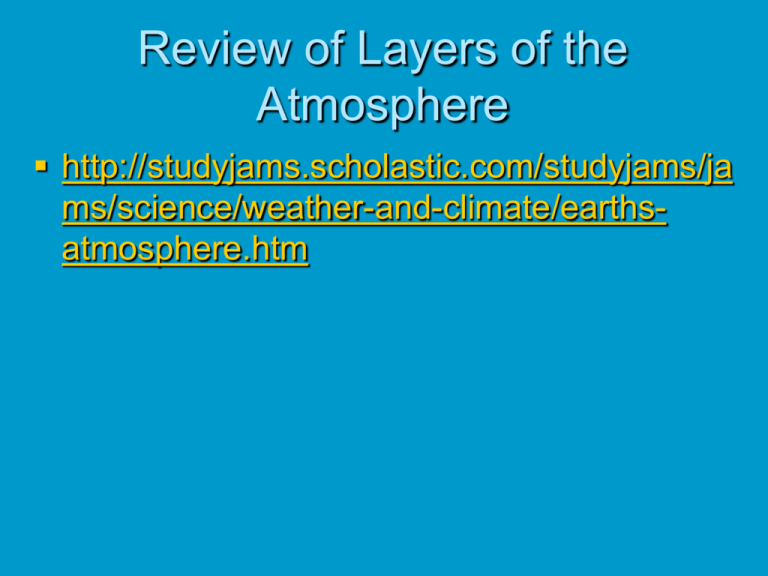
Review of Layers of the Atmosphere http://studyjams.scholastic.com/studyjams/ja ms/science/weather-and-climate/earthsatmosphere.htm Heat Transfer Heat transfer is the movement of thermal energy from a warmer item to a cooler item. Remember, heat moves in predictable ways, from a high to a low. If I open the front door, does the heat go OUT or does the cold come IN? The thermal energy goes from HOT areas to COLD. The heat goes OUT Heating of the Earth The Sun provides most of Earth’s energy. The Sun’s energy can be – Reflected back into space by clouds, particles, or Earth’s surface – Absorbed by the atmosphere – Absorbed by the surface- land and water This heat energy causes wind and ocean currents. Three types of heat transfer Conduction Convection Radiation Conduction Conduction is heat transfer through solids. The transfer of heat between substances that are in direct contact. Examples: Your feet transfer (conduct) heat to a cold tile floor A spoon placed in hot soup becomes warmer as the spoon conducts heat away from the hot soup Conduction examples Conductors are materials that allow heat to pass through easily. Ex. Metals are the best conductors of heat, whereas air is the worst conductor of heat. Which one(s) are good conductors? Insulators are materials that do not allow heat to pass through easily Examples: glass, ceramics and rubber Which spoon is a conductor? Which spoon is an insulator? Which spoon would you choose to stir with and why? –Convection: transfer of heat from one place to another through circulation of material. Example, heat flowing through air or water In the ocean, warm currents move heat from the equator to higher latitudes through convection currents. More direct light at the equator = warmer ocean temperatures at the equator Convection occurs in fluids A fluid is defined as a liquid or gas because fluids have the ability to flow from one place to another Solids, however, maintain their position Convection within the Earth Divergent Boundary Mid Ocean Ridge Material in the mantle is heated by the outer core and it rises, pushing apart the plates of the crust Convergent Boundary Trench How do you feel the Sun’s heat even when you aren’t in direct contact with it? Radiation: transfer of heat from one place to another in the form of rays or waves. Examples heat from the sun, microwave Heat can travel in waves without a medium (a liquid, solid, or gas). Radiation is the term that describes heat movement without a medium of matter. Review Conduction Convection Radiation Convection Conduction Conduction Radiation Convection Radiation Conduction Can you explain why you feel warm when you are standing away from a campfire? – Radiation Why does a carpeted floor feel warmer to bare feet than tile even though both surfaces are the same temperature? – Better conductor What information would you need in order to predict whether heat transfer would occur when two objects or materials interact? – Are they the same temperature? If no, then heat will flow from the hotter object to the colder one. – Is it an insulating material or a conducting material? If it is insulating, there will be little or no heat transfer. Name each type of heat transfer Review Videos http://www.wisconline.com/objects/heattransfer/ (with audio) http://vitalnj.pbslearningmedia.org/asset/lsps 07_int_heattransfer/ PBS heat transfer tutorial http://www.youtube.com/watch?v=wr8Z4SCE TPs Heat transfer song, by Mr. Parr
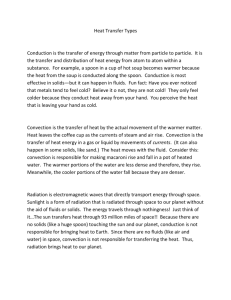
![Applied Heat Transfer [Opens in New Window]](http://s3.studylib.net/store/data/008526779_1-b12564ed87263f3384d65f395321d919-300x300.png)
